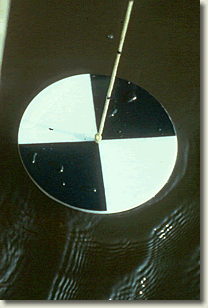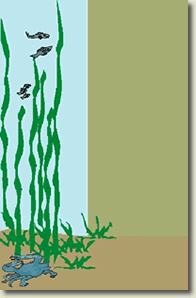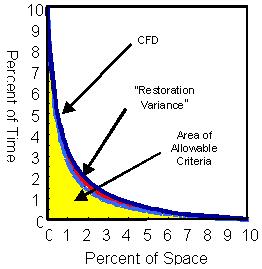Frequently Asked Questions: Chesapeake Bay Water Quality Standards
Main_Content
The Chesapeake Bay tidal waters designated uses, reflect the variety of habitats found throughout the Bay and its tidal tributaries. The Bay's fish, crabs, oysters and underwater grasses are distinguished by natural habitats that differ by salinity and depth as reflected by the subcategory designated uses described in the table below.
Subcategory
Designated Use | What is Protected | Habitats and Locations
|
1. Migratory Fish Spawning and Nursery | Migratory fish including striped bass, perch, shad, herring and sturgeon during the late winter/spring spawning and nursery season.
| In tidal freshwater to low-salinity habitats. This habitat zone is primarily found in the upper reaches of many Bay tidal rivers and creeks and the upper mainstem Chesapeake Bay.
|
2. Shallow-Water Submerged Aquatic Vegetation | Underwater bay grasses and the many fish and crab species that depend on this shallow-water habitat.
| Shallow waters provided by grass beds near the shoreline. |
3. Open-Water Fish and Shellfish | Water quality in the surface water habitats to protect diverse populations of sportfish, including striped bass, bluefish, mackerel and seatrout, bait fish such as menhaden and silversides, as well as the shortnose sturgeon, and endangered species.
| Species within tidal creeks, rivers, embayments and the mainstem Chesapeake Bay year-round. |
4. Deep-Water Seasonal Fish and Shellfish | The many bottom-feeding fish, crabs and oysters, and other important species such as the bay anchovy. | Living resources inhabiting the deeper transitional water column and bottom habitats between the well-mixed surface waters and the very deep channels during the summer months. The deep-water designated use recognizes that low dissolved oxygen conditions prevail during the summer due to a water density gradient (pycnocline) formed by temperature and salinity that reduces re-oxygenation of waters below the upper portion of the gradient.
|
5. Deep-Channel Seasonal Refuge | Bottom sediment-dwelling worms and small clams that act as food for bottom-feeding fish and crabs in the very deep channel in summer.
| Deep-channel designated use recognizes that low dissolved oxygen conditions prevail in the deepest portions of this habitat zone and will naturally have very low to no oxygen during the summer. |
Dissolved Oxygen
Fish and other aquatic life require levels of dissolved oxygen to survive. Seasonal algae blooms deplete dissolved oxygen, and may render deep waters of the Bay uninhabitable to certain species. It affects species such as the endangered Atlantic Sturgeon and striped bass during certain times of the year. Dissolved oxygen criteria levels were determined by the communities inhabiting the different depths and salinities of the Bay at different times of the year.
| Subcategory Designated Use | Criteria | Temporal Application
|
| Migratory Fish Spawning and Nursery | 7 day mean >= 6 mg liter-¹ *
Instantaneous minimum >= 5 mg liter-¹
| February 1 - May 31 |
| Open-Water Fish and Shellfish¹ ² | 30 day mean of >=5.5 mg liter-¹ in low salinity; 5 mg liter-¹ in high salinity
7 day mean of >= 4 mg liter-¹
Instantaneous minimum of >= 3.2 mg liter-¹
| Year-round |
Deep-Water Seasonal Fish and Shellfish | 30 day mean of >= 3 mg liter-¹
1 day mean of >= 2.3 mg liter-¹
Instantaneous minimum of >= 1.7 mg liter-¹
| June 1 - September 30 |
Deep-Channel Seasonal Refuge | Instantaneous minimum of >= 1 mg liter-¹ | June 1 - September 30
|
*Only applies when the salinity is less than or equal to 0.5 parts per thousand.
Water Clarity
| Salinity Regime | Water Clarity Criteria as
Percent Light-through-Water | Temporal Application |
| Tidal Fresh | 13% | April-October |
| Oligohaline | 13% | April-October |
| Mesohaline | 22% | April-October |
| Polyhaline | 22% | March-May,
September-November
|

 Underwater grasses are an essential component of the Bay's living resources habitat. Decreased water clarity inhibits the growth of underwater Bay grasses. Increased sediment loads and algal biomass, spurred by excess nutrient inputs to the Bay, will impact water clarity. Bay water quality conditions should have high water clarity to allow sunlight to penetrate, and support underwater grass restoration throughout the Bay's shallow-water habitats.
Underwater grasses are an essential component of the Bay's living resources habitat. Decreased water clarity inhibits the growth of underwater Bay grasses. Increased sediment loads and algal biomass, spurred by excess nutrient inputs to the Bay, will impact water clarity. Bay water quality conditions should have high water clarity to allow sunlight to penetrate, and support underwater grass restoration throughout the Bay's shallow-water habitats.
The criteria involve SAV (Submerged Aquatic Vegetation) restoration goals (acres of standing SAV crop), and/or measuring water clarity criteria using a Secchi disk technique.
Resources
 Restoration variances for certain Chesapeake Bay and tidal tributary segment designated uses allow for temporary exceedances of the dissolved oxygen (DO) criteria in situations when, based on model runs, it appears that achieving the criteria may be unattainable even under the most optimistic restoration scenarios.
Restoration variances for certain Chesapeake Bay and tidal tributary segment designated uses allow for temporary exceedances of the dissolved oxygen (DO) criteria in situations when, based on model runs, it appears that achieving the criteria may be unattainable even under the most optimistic restoration scenarios.
Using restoration variances allows Maryland to maintain the current DO criteria without adopting a less stringent criteria and while collecting additional information that may help to improve our understanding of these segments and potentially confirm what the highest attainable condition is. These restoration variances are reviewed and will be updated periodically as new information and data enhances our understanding of the dynamics of DO in these segments.
Center_Content
Contact Information
Please direct questions or comments concerning Frequently Asked Questions - Chesapeake Bay Water Quality Standards to Melinda Cutler at melinda.cutler@maryland.gov.
Last Updated 08/2023
